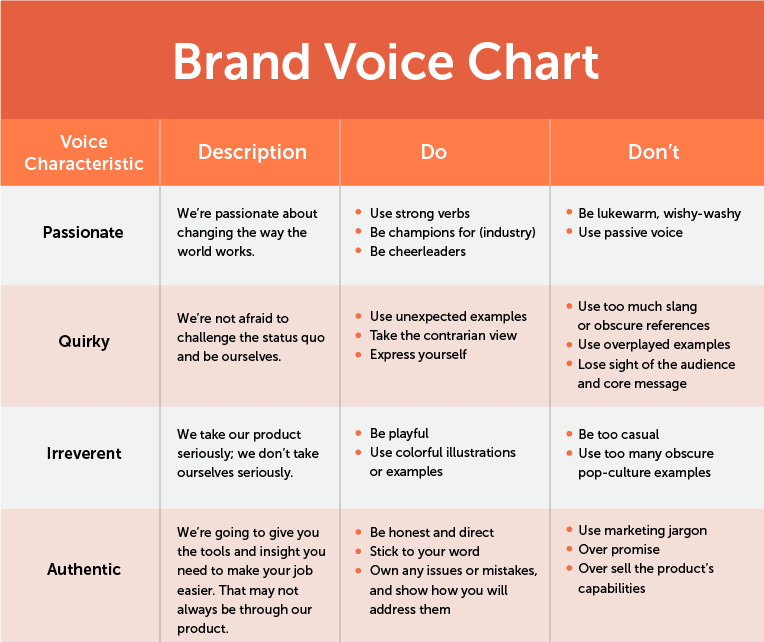
Whether you build your brand from scratch or rebranding it, you need to know who you are and how to communicate it effectively. Building a brand that connects with consumers and adds true value to a product or service is a tricky business. Your brand voice is a big part of your overall brand identity, from your company’s name to your logo design, from your product’s packaging to the colors you use on your website and to the videos in your Facebook ads. Every element of how you present your brand to the world has been planned and discussed thoughtfully from the day of your company’s founding. If you want to capture people’s attention with a great impression, show them what your brand speaks of and it’s important to understand what your brand voice is and how to use it. Of course, identifying your brand voice isn’t always the easiest thing to do. We know this because we’ve gone through the process many times with many brands. It definitely requires some reflection and an intimate understanding of who you are.
So let’s answer the big question first: What is a brand voice and how will it benefit your business?
Brand voice is the consistent expression of a brand’s core messages, values, and personality through the purposeful use of words and prose styles. It is the linguistic representation of all the individual elements that make up your brand and manage how that brand is perceived by the consumers who are aware of – or interact with – your brand and its products in any way.
Having a consistent voice helps to stabilize your brand and makes it easier for people to connect with your company. Studies show consumers are more likely to do business with a brand they trust, and this trust is often established through shared values. For example, if a person is environmentally conscious, they’ll be more inclined to shop at eco-friendly stores. In recent years, consumers have become increasingly particular about which brands they want to continually associate with and support. That’s why establishing the right brand voice can help you win devoted customers, often for life. In addition to earning strong brand loyalty, developing a consistent brand voice across all media platforms gives your brand a cohesive feel. After a while, people will know what to expect from your company; if done correctly, they’ll come to associate your brand with a few words or feelings.
Your brand voice is everywhere. So it’s crucial to have it perfected and implemented. Here are our five steps to achieving a strong and consistent voice for your brand.
Define your target audience
It is crucial to know who you speak to, what’s their interests? Your target gender? In what age range usually needs your services? You need to be specific in your target so you can be successful in your brand voice. It will allow your company to connect with your target audience so that they will want to engage with your company.
Make it Unique
Now that you’re done defining your target audience, it’s time for you to make your brand voice different from others or competitors. For example, if your brand was a person, how would you describe its personality to someone? At this point, also talk about how you would describe your competitors as people, too. How do your brand’s personality traits make you different? You also need to evaluate your competitors, what makes them stand out in a crowd? It will allow you to generate ideas on where your company can shine over your competition.
Create a brand voice chart
With your brand’s voice defined, illustrate how it turns up more concretely in your content with a brand voice chart. You can ask for help from your content creator in brainstorming to produce ideas for brand personality traits. For example, pick up three words that will identify your brand and define it further in a chart. It will be an essential reference tool to ensure your content (text and visuals) is consistently using the same voice.
Each word should define further its characteristics. In creating a chart, include three rows for each of the primary characteristics accompanied by three columns – a brief description, do’s, and don’ts. If necessary, add a row for any secondary characters that need a little extra explanation.

Understand how to put your brand voice into action
You’ve defined your voice and tone and shown it in an easy-to-understand chart. Now, how do you get everyone on board with using it? Meet with the team – anyone who creates content or communications – and walk them through the chart. Go through some examples of content that hits the mark, and show in real-time how you would revise some existing content that isn’t reflective of the defined voice to realign to it. Again, it will be an essential reference tool to ensure your content (text and visuals) is consistently using the same voice.
Revisit and Revise
A brand voice chart is not meant to be a one-time-set-it-and-forget-it tool. As your brand messaging evolves or new competitors come into your market, it’s good to take a look at the chart and refresh it with new examples.
On a quarterly basis, convene your key content creators and communicators to find out if any voice attributes haven’t been working well or are more aspirational than possible for whatever reason. For instance, many brands initially include “irreverence,” but find that many of their writers are uncomfortable flexing that muscle or that copy is consistently deleted by your key approvers. If that’s the case, it may be time for a voice refresh, or some new dos and don’ts.
The most successful brands have managed to make their brand voice the soul of their brand, central to how they communicate with customers. Creating a comprehensive brand voice strategy can take months or even years; it is a worthy investment. By bringing a touch of humanity to your brand, you will stand out from a crowd of competitors and win the favor of consumers.







